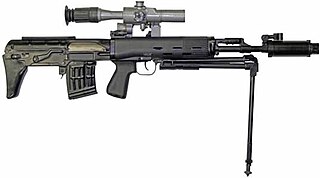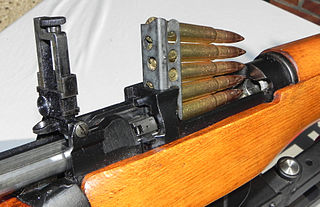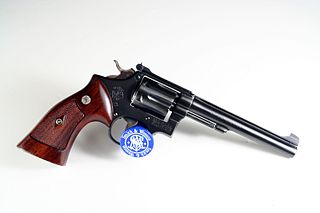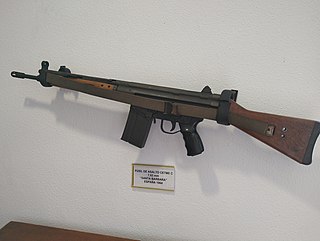Related Research Articles

A revolver is a repeating handgun that has at least one barrel and uses a revolving cylinder containing multiple chambers for firing. Because most revolver models hold up to six cartridges, before needing to be reloaded, revolvers are commonly called six shooters or sixguns. Due to their rotating cylinder mechanism, they may also be called wheel guns.

In firearms terminology, an action is the functional mechanism of a breech-loading firearm that handles the ammunition cartridges, or the method by which that mechanism works. Actions are technically not present on muzzleloaders, as all those are single-shot firearms with a closed off breech with the powder and projectile manually loaded from the muzzle. Instead, the muzzleloader ignition mechanism is referred to as the lock.

The Colt AR-15 is a lightweight, magazine-fed, gas-operated semi-automatic rifle. It is a semi-automatic version of the M16 rifle sold for the civilian and law enforcement markets in the United States. The AR in AR-15 stands for "ArmaLite Rifle", after the company that developed it in the 1950s. Colt's Manufacturing Company currently owns the AR-15 trademark for its line of semi-automatic AR-15 rifles.

A bullpup firearm is one with its firing grip located in front of the breech of the weapon, instead of behind it. This creates a weapon with a shorter overall length for a given barrel length, and one that is often lighter, more compact, concealable and more maneuverable than a conventionally configured firearm. Where it is desirable for troops to be issued a more compact weapon, the use of a bullpup configuration allows for barrel length to be retained, thus preserving muzzle velocity, range and ballistic effectiveness.

Smith & Wesson Brands, Inc. (S&W) is an American firearm manufacturer headquartered in Maryville, Tennessee, United States.
Winchester rifle is a comprehensive term describing a series of lever action repeating rifles manufactured by the Winchester Repeating Arms Company. Developed from the 1860 Henry rifle, Winchester rifles were among the earliest repeaters. The Model 1873 was particularly successful, being marketed by the manufacturer as "The Gun That Won the West".

A stripper clip is a speedloader that holds several cartridges together in a single unit for easier and faster loading of a firearm magazine.

Benjamin Tyler Henry was an American gunsmith and manufacturer. He was the inventor of the Henry rifle, the first reliable lever-action repeating rifle.

Harrington & Richardson Arms Company is an American brand of firearms and a subsidiary of JJE Capital Holdings. H&R ceased independent production February 27, 2015.

The M1917 Revolvers were six-shot, .45 ACP, large frame double action revolvers adopted by the United States Military in 1917, to supplement the standard M1911 pistol during World War I. There were two variations of the M1917, one made by Colt and the other by Smith & Wesson. They used moon-clips to hold the cartridges in position, facilitate reloading, and to aid in extraction since revolvers had been designed to eject rimmed cartridges and .45 ACP rounds were rimless for use with the magazine-fed M1911. After World War I, they gained a strong following among civilian shooters. A commercial rimmed cartridge, the .45 Auto Rim, was also developed, so M1917 revolvers could eject cartridge cases without using moon-clips.

The Smith & Wesson Model 17 is a six-shot double-action revolver chambered for .22 LR. It is built on Smith & Wesson's medium-sized K-frame.

Calico Light Weapons Inc. (CLWS) is an American privately held manufacturing company based in Elgin, Oregon, that designs, develops and manufactures semiautomatic firearms. It was established in 1982 in Bakersfield, California, and released its first production weapon in 1985. In 1998 its operations were moved to Sparks, Nevada, where replacement parts for existing weapons were produced.
The Winchester Model 1894 rifle is a lever-action repeating rifle that became one of the most famous and popular hunting rifles of all time. It was designed by John Browning in 1894 and originally chambered to fire two metallic black powder cartridges, the .32-40 Winchester and .38-55 Winchester. It was the first rifle to chamber the smokeless powder round, the .30 WCF in 1895. In 1901, Winchester created the new .32 Winchester Special caliber with production of rifles starting in 1902.

An antique firearm is a term used to describe a firearm that was designed and manufactured prior to the beginning of the 20th century. Although the exact definition of what constitutes an "antique firearm" varies between countries, the advent of smokeless powder or the start of the Boer War are often used as cut-off dates. Antique firearms are usually collected because of their historical interest and/or their monetary value.

A handgun is a firearm designed to be usable with only one hand. It is distinguished from a long gun which needs to be held by both hands and braced against the shoulder. Handguns have shorter effective ranges compared to long guns, and are much harder to shoot accurately. While most early handguns are single-shot pistols, the two most common types of handguns used in modern times are revolvers and semi-automatic pistols, although other handguns such as derringers and machine pistols also see infrequent usage.

In firearms, the cylinder is the cylindrical, rotating part of a revolver containing multiple chambers, each of which is capable of holding a single cartridge. The cylinder rotates (revolves) around a central axis in the revolver's action to sequentially align each individual chamber with the barrel bore for repeated firing. Each time the gun is cocked, the cylinder indexes by one chamber. Serving the same function as a rotary magazine, the cylinder stores ammunitions within the revolver and allows it to fire multiple times before needing to reload.

The CETME Model 58 is a stamped-steel, select-fire battle rifle produced by the Spanish armaments manufacturer Centro de Estudios Técnicos de Materiales Especiales (CETME). The Model 58 used a 20-round box magazine and was chambered for the 7.62×51mm NATO round. The CETME 58 would become the foundation of the widely deployed German Heckler & Koch G3 battle rifle. Semi-automatic variants were also produced for the civilian market.

The Smith & Wesson M&P15 is an AR-15 style semi-automatic rifle by Smith & Wesson. Introduced in 2006, the firearm is designed for police use and consumer markets.

The Smith & Wesson M&P15-22 is a .22 Long Rifle variant of the Smith & Wesson M&P15 semi-automatic rifle, but is blowback-operated rather than direct impingement-operated. It is intended for recreational shooting ("plinking") and small game hunting. It is made with a polymer upper and lower receiver rather than the aluminum alloy that is normally used in AR-15 style rifles, and uses proprietary polymer box magazines.

A cadet rifle is a rifle used by military cadets and others for basic firearms and marksmanship training. Generally .22 caliber and bolt-action, they also come in semi-automatic versions. They are often miniature .22 caliber versions of standard issue service rifles.
References
- 1 2 3 4 5 6 7 8 Canfield, Bruce N. (November 2012). "A Bad Investment: Smith & Wesson Model 1940 Light Rifle". American Rifleman . Vol. 160, no. 11. pp. 54–57.
- 1 2 Peterson, Philip (5 January 2017). Standard Catalog of Military Firearms: The Collectors Price & Reference Guide. Iola, Wisconsin: F+W Media, Inc. pp. 237–238. ISBN 978-1-4402-4676-0.[ permanent dead link ]
- ↑ Supica, Jim; Nahas, Richard (14 November 2016). Standard Catalog of Smith & Wesson. Iola, Wisconsin: F+W Media. pp. 409–410. ISBN 978-1-4402-4565-7.[ permanent dead link ]
Sources
- "Rifles: Smith & Wesson Light Rifle Model 1940 MkI". Ignomini.com. Archived from the original on 5 January 2009.
- "Patent for E. S. Pomeroy Firearm, Serial No. 281,558". Google Patents. 28 June 1939.